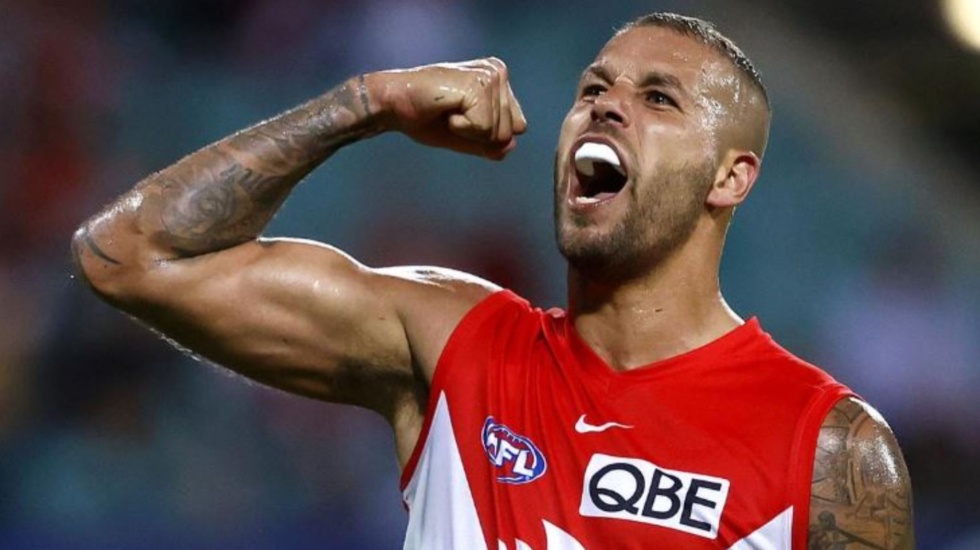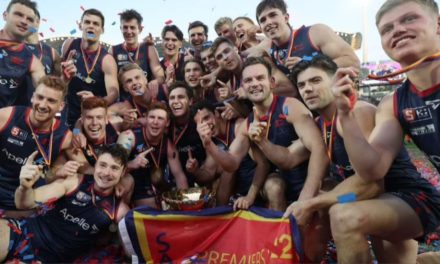He was literally unstoppable. As he remained virtually anytime he determined it was time to put the foot down.
It’s all a bit overwhelming when a legend gives it away, no matter how much you’ve prepared yourself for the inevitable.
Suddenly, a name synonymous with a sport for nigh on two decades disappears from the discussion. So how great is their legacy? Where do they rank among the all-time greats? How did they change the sport?
They’re all important considerations when we assess the impact of Lance “Buddy” Franklin on AFL football over 18 seasons and 354 games with two clubs, Hawthorn and Sydney, producing an incredible 1066 goals, Franklin one of just five men to top the 1000 mark.
Perhaps what’s most important right now, though, as we digest the fact we won’t see one of the most eye-catching handful of players in history do his stuff again on the field, is that we don’t let the inevitable mountain of numbers overwhelm the pictures in our minds, THOSE moments that epitomised the walking highlight reel that was Buddy.
And even with that catalogue of the spectacular, it’s hard to know where to start. What comes first in the mind’s eye?
Is it the couple of incredible goals running along the MCG boundary line against Essendon for Hawthorn in 2010, kicked just seven minutes apart, each a worthy “Goal of the Year” nominee? Or that incredible 13-goal haul for the Hawks against a hapless North Melbourne in Launceston in 2012, and Anthony Hudson’s iconic call that accompanied the last of them?
Is it the dash through the MCG midfield for the Hawks against Collingwood in 2013, the hurdle and 75-metre bomb whilst at full tilt? Or the preliminary final against the same opponent two years previously, the checkside dribbler with Chris Tarrant on his hammer to give the Hawks a late lead?
Or is it earlier? The 20-year-old Buddy in 2007, playing in his first final, getting Hawthorn over the line against Adelaide at Docklands with a deadeye conversion from 50 metres with literally just seconds left on the clock?
And there’s so many more where those came from. The long bombs in the Hawks’ third-quarter blitz against Sydney in the 2012 grand final classic. A reprise seven years later of his 2010 burning off of Bomber Cale Hooker, this time dressed as a Swan, against Adelaide. Etc., etc.
At his peak, the audible buzz from a crowd whenever Franklin got anywhere near the football was louder than for anyone I’ve ever watched play the game, even Gary Ablett senior or Wayne Carey.
And that might be the most important thing. That Franklin transcended mere parochial club allegiances, perhaps interest in the game per se. Even those “heathens” without much interest in Australian football knew who it was flashing on their TV screens in those highlights packages. And were excited by what they saw.
PLEASE HELP US CONTINUE TO THRIVE BY BECOMING AN OFFICIAL FOOTYOLOGY PATRON. JUST CLICK THIS LINK.
And how could you not be? Here was a man of 199-centimetres height and weighing more than 100 kilograms moving at lightning speed and as agile as the lightest ground-level player, physical assets complemented by a tremendous football brain and superlative touch, Franklin’s field kicking, let alone his thunderous long-range goalkicking, a thing of beauty.
Incredibly, for a player already acknowledged as one of the greatest handful the game has seen, for his entire career there remained debate about Franklin’s relative lack of prowess as an overhead mark.
He wasn’t a high-leaper, or consistent pack mark. Many of his goals were the result of sharp leads up the ground, or ground-level agility once the ball had hit the deck. Like a lot of left-footers, Franklin wasn’t great on his non-preferred side.
But so strong were those assets he did have, they consistently allowed him enough of an edge over his opponents to more than compensate for the parts of his make-up which weren’t outstanding. And with those gifts, Franklin could make even the seemingly routine look spectacular.
That’s what we must remember. And yet, paradoxically, perhaps it is one figure in particular which helps tell the ultimate tale of just how good this man was as an AFL player. And that is the 102 goals (113 for the season including finals) with which Franklin won the 2008 Coleman Medal.
As team defence improved, forward 50s became crowded and scoring plummeted just as Franklin was coming into the game, so did goalkickers find the going increasingly tough.
The three Coleman medallists immediately preceding Buddy kicked 74, 84 and 77 goals. The three immediately after him did it with tallies of 86 goals, 78 and 71. By the time he won his second Coleman in 2011, even Franklin did so with just 71 goals. His two won subsequently with Sydney were with tallies in the 60s.
All of which makes that ton in 2008, surely the last league football will ever see, even more incredible. Franklin kicked bags of six or more an incredible nine times that year, including one of eight in a final.
He was literally unstoppable. As he remained right up until his last couple of seasons virtually anytime he determined it was time to put the foot down. He did it with equal measures of power and elegance, and always with the most incredible impact. And continued to even as the game changed around him.
It was something to behold. And we’re all lucky to have been privy to it.
This article first appeared at ESPN.










